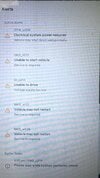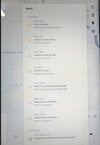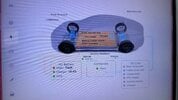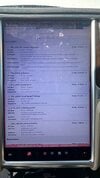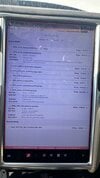Oui, j'ai rencontré des problèmes liés à l'eau sur ma Model S 2014. La plupart des mêmes messages d'erreur que vous, voir l'image ci-jointe.
Histoire courte:
Le réchauffeur de liquide de refroidissement présentait une faible résistance d'isolement entre l'alimentation 400 V de la batterie et le châssis lorsqu'il était mouillé. Le changement du réchauffeur de liquide de refroidissement a résolu le problème.
Longue histoire:
Après avoir séché la voiture pendant un moment, la voiture repartait. Pour moi, cela s'est également produit en conduisant lorsqu'il pleuvait. La deuxième fois que cela s'est produit, j'ai fait remorquer la voiture jusqu'au centre de service Tesla le plus proche. Malheureusement, ils ont laissé la voiture dehors au soleil pendant une semaine avant de pouvoir la regarder, donc elle a bien sûr séché là... Le technicien de service travaillant sur ma voiture m'a en fait appelé, et la seule raison possible qu'il a pu voir était signes possibles d'humidité séchée dans la partie onduleur de l'unité d'entraînement. Il a donc recommandé de changer l'unité de transmission arrière.
J'ai poliment dit non merci, de faibles signes d'humidité ne suffisent pas pour moi à faire face à un tel investissement.
En récupérant la voiture, j'ai commencé à expérimenter et j'ai découvert que le problème se trouvait à l'avant de la voiture, simplement par élimination. J'ai un RWD classique, donc seuls les éléments connectés au système 400 V sont le convertisseur DC-DC derrière la roue avant du passager, le compresseur de climatisation sous le coffre, le chauffage de l'habitacle à l'intérieur du tableau de bord et le chauffage du liquide de refroidissement de la batterie à côté du frunk.
J'ai retiré le coffre et j'ai obtenu un accès facile au réchauffeur de liquide de refroidissement et au compresseur de climatisation. J'ai soigneusement pulvérisé le réchauffeur de liquide de refroidissement avec de l'eau et les erreurs ont commencé à apparaître en quelques minutes. J'ai séché le réchauffeur de liquide de refroidissement avec de l'air chaud pendant quelques heures, les erreurs ont disparu. Encore une fois, même chose.
J'ai acheté un nouveau réchauffeur de liquide de refroidissement chez Tesla, je l'ai échangé et je n'ai eu aucun problème depuis près de 6 mois maintenant, y compris plusieurs lavages de voiture et une conduite sous de fortes pluies.
Remarque : Le réchauffeur de liquide de refroidissement est connecté au système 400 V comme mentionné, alors assurez-vous de suivre les étapes correctes pour assurer la sécurité du processus !
Je n'ai vu personne d'autre vivre cela, donc avec vos problèmes, j'ai pensé qu'il pourrait être utile de partager mon expérience.



